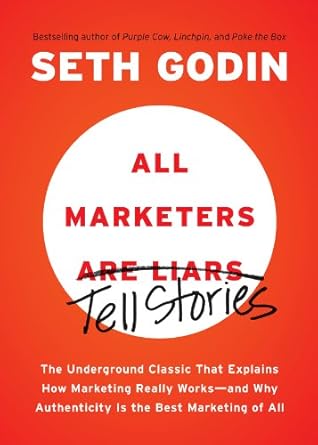More on this book
Community
Kindle Notes & Highlights
by
Seth Godin
Read between
April 11 - June 16, 2017
Frames are the words and images and interactions that reinforce a bias someone is already feeling.
Speaking respectfully to a person’s worldview is the price of entry to get their attention.
Geoffrey Moore talks about in Crossing the Chasm: moving from the early adopters to the mass market.
You’re more likely to succeed as long as you avoid winner-take-all contests.
It’s not enough to find a niche that shares a worldview. That niche has to be ready and able to influence a large group of their friends.
you reach people who have a worldview that the messages you promise to send them are a valuable part of their lives.
poor word use is just a red flag for someone who wants to ignore you.
A worldview is the lens used to look at every decision a person is asked to make.
What makes them a community is that they talk to each other.
a shared worldview doesn’t make a community!
the best marketing goes on when you talk to a group that shares a worldview and also talks about it—a community.
The desire to do what the people we admire are doing is the glue that keeps our society together. It’s the secret ingredient in every successful marketing venture as well.
those who believe your story will work hard to share their lie with their peers.
If your story is easy to spread, and if those you converted believe that it’s worth spreading, it will.
A lot of people want what everyone else is buying.
the fear of change is greater than the cost of sticking with what you’ve got.
Step 1: Every consumer has a worldview that affects the product you want to sell. That worldview alters the way they interpret everything you say and do. Frame your story in terms of that worldview, and it will be heard.
Instead of being scientists, the best marketers are artists.
Step 2: People only notice stuff that’s new and different. And the moment they notice something new, they start making guesses about what to expect next.
almost every important buying decision is made instantaneously.
The vast majority of job interviews are over in less than five minutes.
In order to survive the onslaught of choices, consumers make snap judgments.
Only when a business or organization (or person) is authentic can we be sure that the story that’s being told is consistent enough to impact the maximum number of people.
Superstitions are nothing but incorrect theories based on snap judgments.
use personal interactions that are so extraordinary and so powerful that they cause people to tell themselves a different story instead.
Facts are not the most powerful antidote to superstition. Powerful, authentic personal interaction is.
believing a lie is not quite the same as understanding reality.
Step 3: Humans are able to make extremely sophisticated judgments in a fraction of a second. And once they’ve drawn that conclusion, they resist changing it.
Consumers pretend that they’re rational and careful and thoughtful about the stuff they buy. Actually they’re not. Instead they rely on stories.
Even if the story is based on fact, all the stories people rely on to make decisions are blown out of proportion.
If you start a campaign unable to speak to the people who need to hear your message, you’ve lost before you even begin—
Stories only work because consumers buy what they don’t need.
the reason they buy stuff they want is because of the way it makes them feel.
The myth of product superiority in business-to-business products is just that.
Step 4: Stories let us lie to ourselves. And those lies satisfy our desires. It’s the story, not the good or the service you actually sell, that pleases the consumer.
growth starts with better questions. Questions about storytelling, not about commodities.
The process of discovery is more powerful than being told the right answer—
Expectations are the engine of our perceptions.
The ideas are the same but the lie is different. And the lie is at least as important as the ideas inside.
Storytelling works when the story actually makes the product or service better.
A fraud is a story that’s told solely for the selfish benefit of the marketer. A fraud is marketing with side effects.
Just because people might believe your story doesn’t give you a right to tell it!
To disclaim responsibility for a fraud is cowardly.
It’s almost impossible to keep a tangled story straight.
once consumers are able to see the effect that stories have on them, they’ll be in a much better position to believe the good ones and avoid the bad.
Yes, you need a story. No, it may not be inauthentic.
Your story fails when the person who believed it decides it fails.
When we recognize the fraud for what it is, we feel incredibly stupid.
Doing the right thing pays off. Storytellers who trick consumers get caught.
if you want to grow, make something worth talking about.


